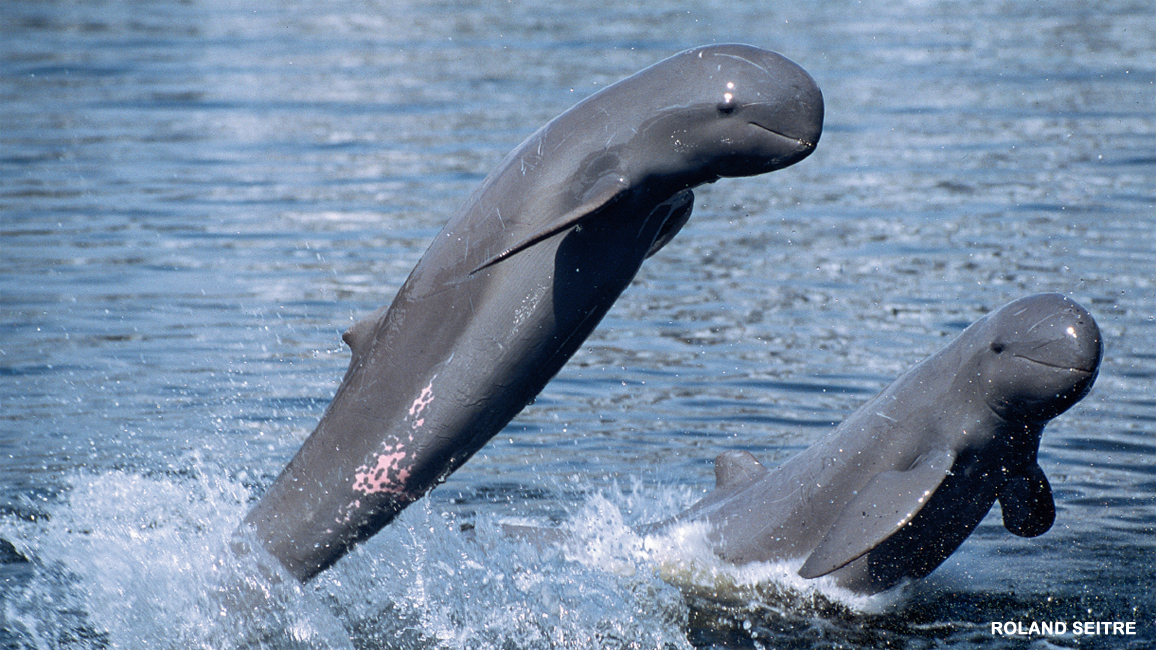
Irrawaddy Dolphins
By Gerry Bishop; Photos by Roland Seitre
With all this spitting and splashing going on, you might guess that these dolphins like to have fun. But they also help out when there’s work to be done.
Irrawaddy (EAR-uh-WAH-dee) dolphins are among the strangest and rarest dolphins on Earth. Few people have ever heard about them, but, in a land far off in Asia, they’re the best friends a fisherman can have. Keep reading to find out why.

Imagine that you live in a world very different from your own. You and your family share a one-room hut on the shore of a wide river. Every morning you wake up early and go out with your father in a tiny boat to catch fish.
You and your father aren’t fishing for fun. Instead, you’re fishing to survive. With luck you’ll catch enough fish to feed your family for the day. And with a little more luck, you’ll catch enough to sell in a market and earn some money.
This hard life is not make-believe. It happens every day along the Ayeyarwady (a-yar-WAH-dee) River in a country called Myanmar (my-AN-mar). (See map below.) And thanks to the friendly dolphins that live there, the fishing is sometimes a lot easier. Follow along from scene to scene to see what we mean.
1. CALLING ALL DOLPHINS
One fisherman slaps a paddle blade on the water while another taps the side of the boat with a piece of wood. In the distance, Irrawaddy dolphins hear the noise. A few dolphins may pop their heads out of the water, spy the boat, and dive back under. Then the dolphins slap the water with their tails. Yes, we’ll help you, they seem to be telling the hopeful fishermen.
2. ROUNDING ’EM UP
The dolphins now go to work. They start swimming in circles around a school of fish. They’re herding the fish closer to the fishermen’s boat!
3. TIME FOR THE TOSS
When the school of fish is close to the boat, a dolphin waves its tail above the surface. The fishermen see that as a signal to throw their net. They send the net flying over the school of fish.
4. ENOUGH FOR EVERYONE
The net sinks into the water and traps the fish inside it. Then the fishermen drag their catch toward the boat. Some of the confused and stunned fish escape, but the dolphins are there to gulp them up. The dolphins get an easy catch—and so do the fishermen.
SOME HARM AND SOME HELP
Dolphins have been helping fishermen along the Ayeyarwady for as long as anyone can remember. Young dolphins learn from their parents, and the relationship with the fishermen goes on and on.
But not all people look out for the Irrawaddies. Some fishermen accidentally harm the dolphins with the kinds of nets and other gear that they use. People also have polluted the Ayeyarwady River where the dolphins live. So now there are very few dolphins left.
Here’s the good news: Many other people are trying to help the dolphins. They’re working to pass laws that protect the dolphins from harmful fishing gear, pollution, and other problems—and to make sure the laws are obeyed.
So who knows? Maybe soon the Irrawaddies will have all the protection they need. And with luck, someday there will be many more of these dolphins around, ready to help their fishermen friends.
FAST FACTS: Irrawaddy dolphins were named after the river they live in, which is now spelled “Ayeyarwady.”
Some Irrawaddies also live in salt water along the seacoast (see map below).

OTHER FRESHWATER DOLPHINS
Most of the dolphins that people know and love live in oceans and seas, which are salt water. But some species of dolphins—such as the Irrawaddy—live in salt water or fresh water. And a few species live only in fresh water. Shown here are two freshwater dolphins.
AMAZON RIVER DOLPHIN (Also called pink river dolphin)
- Eats about 50 different kinds of fish—including piranhas.
- Is gray when young but then turns pink when older.
- When the Amazon River floods the surrounding forests, it hunts prey among the tree roots.
GANGES (or INDUS) RIVER DOLPHIN
- Feeds along the bottom of muddy rivers on fish, shrimp, and other creatures. May also eat turtles or even waterbirds.
- Has eyes that can only tell light from dark.
- Now very rare and in danger of becoming extinct.
















